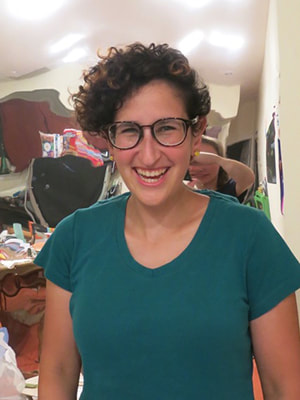
Rebecca Fishman
Ph.D. Student, Physics & Astronomy
200 S. 33rd St
201 Moore Building
Philadelphia, PA 19104
Email: rebfish@sas.upenn.edu
Phone: (215) 898-8312
Fax: (215) 573-2068
Becca received her B.A in physics from The University of Chicago in 2015. She is currently working on quantum optical spectroscopy of nanowires and 2D materials and is also interested in nanodiamond quantum sensing.
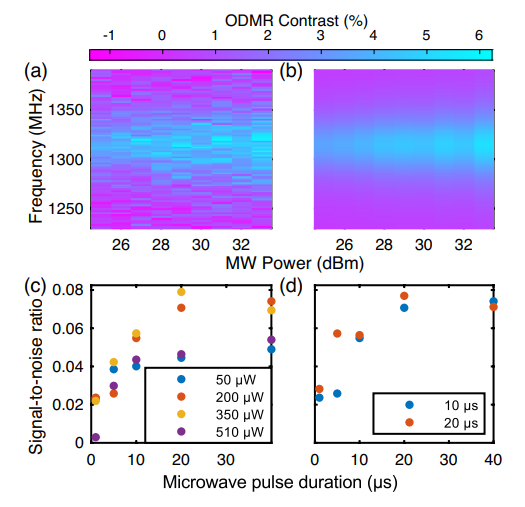 | Patel, Raj N; Fishman, Rebecca E K; Huang, Tzu-Yung; Gusdorff, Jordan A; Fehr, David A; Hopper, David A; Breitweiser, Alex S; Porat, Benjamin; Flatté, Michael E; Bassett, Lee C Dynamical Characterization and Room-Temperature Control of an Optically Addressable Single Spin in Hexagonal Boron Nitride Journal Article Forthcoming Forthcoming. @article{Patel2023, title = {Dynamical Characterization and Room-Temperature Control of an Optically Addressable Single Spin in Hexagonal Boron Nitride}, author = {Raj N. Patel and Rebecca E. K. Fishman and Tzu-Yung Huang and Jordan A. Gusdorff and David A. Fehr and David A. Hopper and S. Alex Breitweiser and Benjamin Porat and Michael E. Flatté and Lee C. Bassett}, url = {https://arxiv.org/abs/2309.05604}, year = {2023}, date = {2023-09-14}, abstract = {Hexagonal boron nitride (h-BN), a wide bandgap, two-dimensional solid-state material, hosts pure single-photon emitters that have shown signatures of optically-addressable electronic spins. Here, we report on a single emitter in h-BN exhibiting optically detected magnetic resonance at room temperature, and we propose a model for its electronic structure and optical dynamics. Using photon emission correlation spectroscopy in conjunction with time-domain optical and microwave experiments, we establish key features of the emitter's electronic structure. Specifically, we propose a model that includes a spinless optical ground and excited state, a metastable spin-1/2 configuration, and an emission modulation mechanism. Using optical and spin dynamics simulations, we constrain and quantify transition rates in the model, and we design protocols that optimize the signal-to-noise ratio for spin readout. This constitutes a necessary step toward quantum control of spin states in h-BN.}, keywords = {}, pubstate = {forthcoming}, tppubtype = {article} } Hexagonal boron nitride (h-BN), a wide bandgap, two-dimensional solid-state material, hosts pure single-photon emitters that have shown signatures of optically-addressable electronic spins. Here, we report on a single emitter in h-BN exhibiting optically detected magnetic resonance at room temperature, and we propose a model for its electronic structure and optical dynamics. Using photon emission correlation spectroscopy in conjunction with time-domain optical and microwave experiments, we establish key features of the emitter's electronic structure. Specifically, we propose a model that includes a spinless optical ground and excited state, a metastable spin-1/2 configuration, and an emission modulation mechanism. Using optical and spin dynamics simulations, we constrain and quantify transition rates in the model, and we design protocols that optimize the signal-to-noise ratio for spin readout. This constitutes a necessary step toward quantum control of spin states in h-BN. |
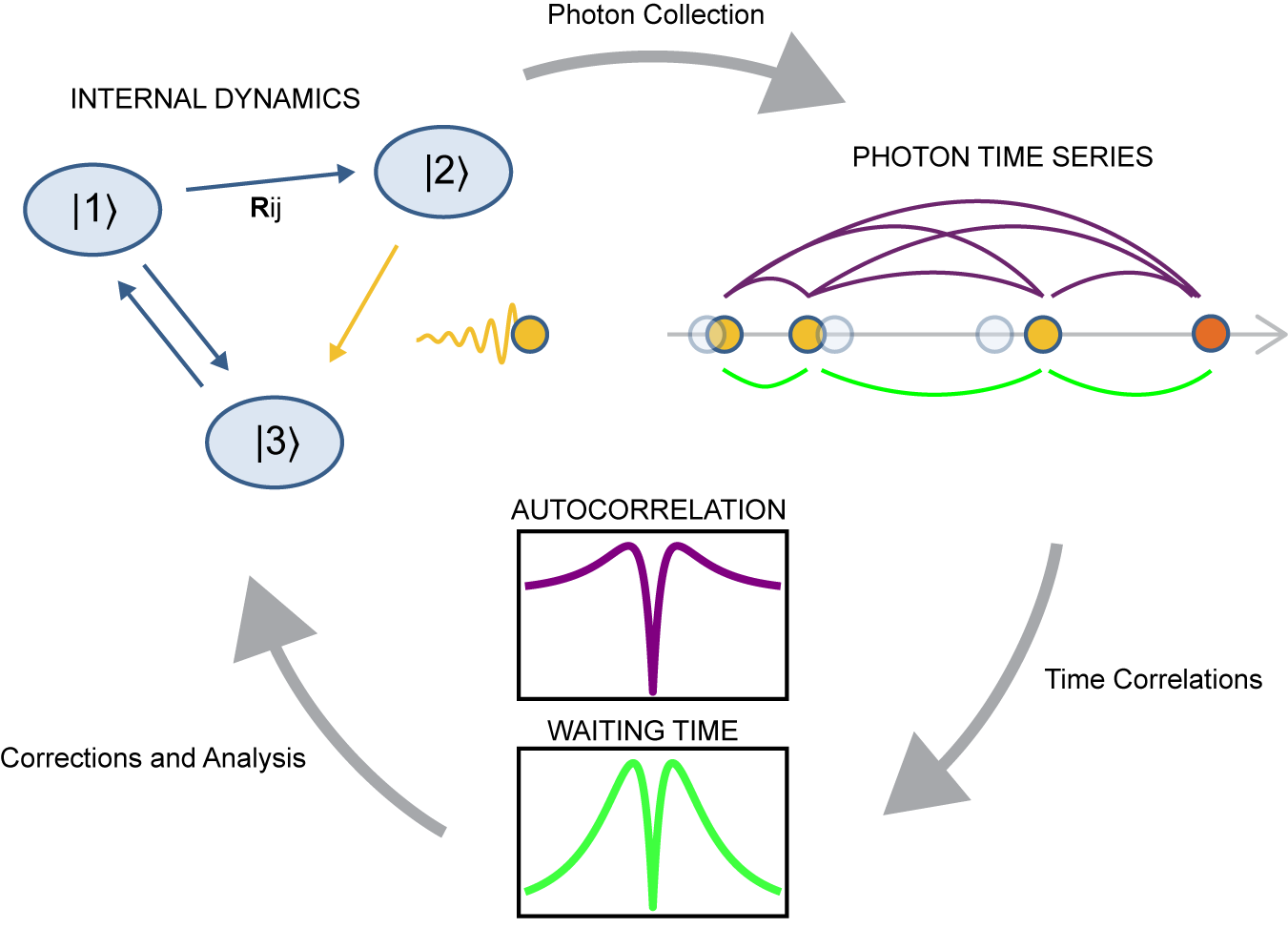 | Fishman, Rebecca E K; Patel, Raj N; Hopper, David A; Huang, Tzu-Yung; Bassett, Lee C Photon emission correlation spectroscopy as an analytical tool for quantum defects Journal Article PRX Quantum, 4 , pp. 010202, 2023. @article{Fishman2021, title = {Photon emission correlation spectroscopy as an analytical tool for quantum defects}, author = {Rebecca E. K. Fishman and Raj N. Patel and David A. Hopper and Tzu-Yung Huang and Lee C. Bassett}, url = {https://journals.aps.org/prxquantum/abstract/10.1103/PRXQuantum.4.010202 https://arxiv.org/abs/2111.01252}, doi = {10.1103/PRXQuantum.4.010202}, year = {2023}, date = {2023-03-06}, journal = {PRX Quantum}, volume = {4}, pages = {010202}, abstract = {Photon emission correlation spectroscopy has a long history in the study of atoms, molecules, and, more recently, solid-state quantum defects. In solid-state systems, its most common use is as an indicator of single-photon emission, a key property for quantum technology. However, photon correlation data can provide a wealth of information about quantum emitters beyond their single-photon purity−information that can reveal details about an emitter's electronic structure and optical dynamics that are hidden by other spectroscopy techniques. We present a standardized framework for using photon emission correlation spectroscopy to study quantum emitters, including discussion of theory, data acquisition, analysis, and interpretation. We highlight nuances and best practices regarding the commonly used g(2)(τ=0)<0.5 test for single-photon emission. Finally, we illustrate how this experimental technique can be paired with optical dynamics simulations to formulate an electronic model for unknown quantum emitters, enabling the design of quantum control protocols and assessment of their suitability for quantum information science applications.}, keywords = {}, pubstate = {published}, tppubtype = {article} } Photon emission correlation spectroscopy has a long history in the study of atoms, molecules, and, more recently, solid-state quantum defects. In solid-state systems, its most common use is as an indicator of single-photon emission, a key property for quantum technology. However, photon correlation data can provide a wealth of information about quantum emitters beyond their single-photon purity−information that can reveal details about an emitter's electronic structure and optical dynamics that are hidden by other spectroscopy techniques. We present a standardized framework for using photon emission correlation spectroscopy to study quantum emitters, including discussion of theory, data acquisition, analysis, and interpretation. We highlight nuances and best practices regarding the commonly used g(2)(τ=0)<0.5 test for single-photon emission. Finally, we illustrate how this experimental technique can be paired with optical dynamics simulations to formulate an electronic model for unknown quantum emitters, enabling the design of quantum control protocols and assessment of their suitability for quantum information science applications. |
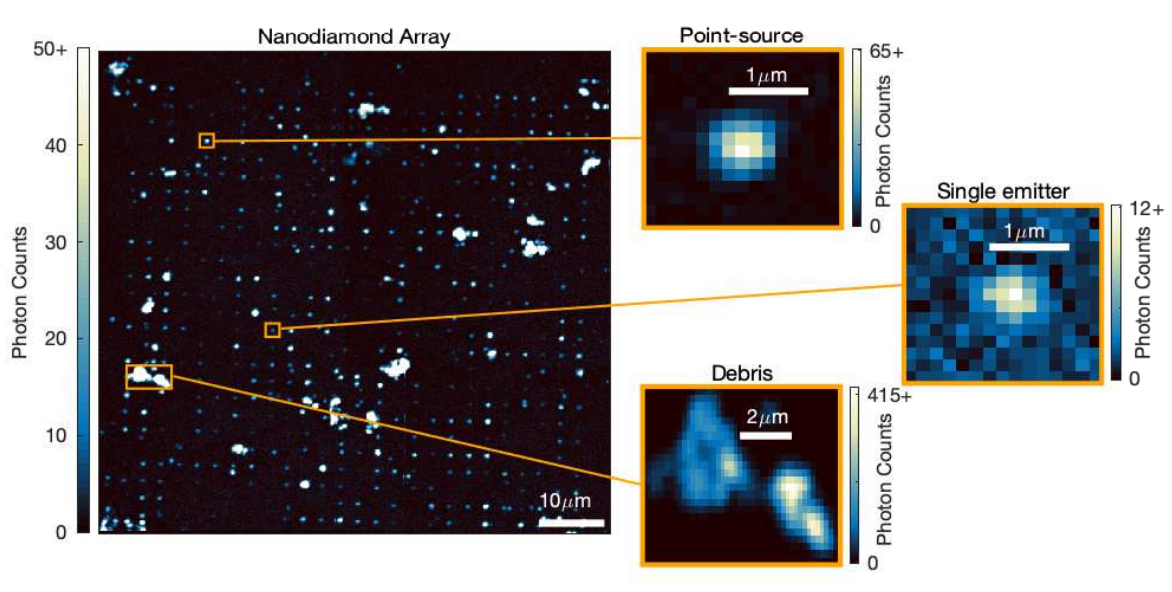 | Narun, Leah R; Fishman, Rebecca E K; Shulevitz, Henry J; Patel, Raj N; Bassett, Lee C Efficient Analysis of Photoluminescence Images for the Classification of Single-Photon Emitters Journal Article ACS Photonics, 9 (11), pp. 3540–3549, 2022. @article{Narun2021, title = {Efficient Analysis of Photoluminescence Images for the Classification of Single-Photon Emitters}, author = {Leah R. Narun and Rebecca E. K. Fishman and Henry J. Shulevitz and Raj N. Patel and Lee C. Bassett}, url = {https://pubs.acs.org/doi/10.1021/acsphotonics.2c00795 https://arxiv.org/abs/2112.05654}, doi = {10.1021/acsphotonics.2c00795}, year = {2022}, date = {2022-10-31}, journal = {ACS Photonics}, volume = {9}, number = {11}, pages = {3540–3549}, abstract = {Solid-state single-photon emitters (SPE) are a basis for emerging technologies such as quantum communication and quantum sensing. SPE based on fluorescent point defects are ubiquitous in semiconductors and insulators, and new systems with desirable properties for quantum information science may exist amongst the vast number of unexplored defects. However, the characterization of new SPE typically relies on time-consuming techniques for identifying point source emitters by eye in photoluminescence (PL) images. This manual strategy is a bottleneck for discovering new SPE, motivating a more efficient method for characterizing emitters in PL images. Here we present a quantitative method using image analysis and regression fitting to automatically identify Gaussian emitters in PL images and classify them according to their stability, shape, and intensity relative to the background. We demonstrate efficient emitter classification for SPEs in nanodiamond arrays and hexagonal boron nitride flakes. Adaptive criteria detect SPE in both samples despite variation in emitter intensity, stability, and background features. The detection criteria can be tuned for specific material systems and experimental setups to accommodate the diverse properties of SPE.}, keywords = {}, pubstate = {published}, tppubtype = {article} } Solid-state single-photon emitters (SPE) are a basis for emerging technologies such as quantum communication and quantum sensing. SPE based on fluorescent point defects are ubiquitous in semiconductors and insulators, and new systems with desirable properties for quantum information science may exist amongst the vast number of unexplored defects. However, the characterization of new SPE typically relies on time-consuming techniques for identifying point source emitters by eye in photoluminescence (PL) images. This manual strategy is a bottleneck for discovering new SPE, motivating a more efficient method for characterizing emitters in PL images. Here we present a quantitative method using image analysis and regression fitting to automatically identify Gaussian emitters in PL images and classify them according to their stability, shape, and intensity relative to the background. We demonstrate efficient emitter classification for SPEs in nanodiamond arrays and hexagonal boron nitride flakes. Adaptive criteria detect SPE in both samples despite variation in emitter intensity, stability, and background features. The detection criteria can be tuned for specific material systems and experimental setups to accommodate the diverse properties of SPE. |
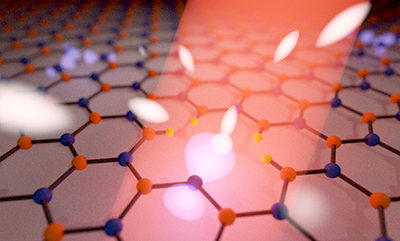 | Patel, Raj N; Hopper, David A; Gusdorff, Jordan A; Turiansky, Mark E; Huang, Tzu-Yung; Fishman, Rebecca E K; Porat, Benjamin; de Walle, Chris Van G; Bassett, Lee C Probing the Optical Dynamics of Quantum Emitters in Hexagonal Boron Nitride Journal Article PRX Quantum, 3 (3), pp. 030331, 2022. @article{Patel2022, title = {Probing the Optical Dynamics of Quantum Emitters in Hexagonal Boron Nitride}, author = {Raj N. Patel and David A. Hopper and Jordan A. Gusdorff and Mark E. Turiansky and Tzu-Yung Huang and Rebecca E. K. Fishman and Benjamin Porat and Chris G. Van de Walle and Lee C. Bassett}, url = {https://journals.aps.org/prxquantum/abstract/10.1103/PRXQuantum.3.030331}, doi = {10.1103/PRXQuantum.3.030331}, year = {2022}, date = {2022-09-01}, journal = {PRX Quantum}, volume = {3}, number = {3}, pages = {030331}, abstract = {Hexagonal boron nitride is a van der Waals material that hosts visible-wavelength quantum emitters at room temperature. However, experimental identification of the quantum emitters’ electronic structure is lacking, and key details of their charge and spin properties remain unknown. Here, we probe the optical dynamics of quantum emitters in hexagonal boron nitride using photon emission correlation spectroscopy. Several quantum emitters exhibit ideal single-photon emission with noise-limited photon antibunching, g(2)(0)=0. The photoluminescence emission lineshapes are consistent with individual vibronic transitions. However, polarization-resolved excitation and emission suggests the role of multiple optical transitions, and photon emission correlation spectroscopy reveals complicated optical dynamics associated with excitation and relaxation through multiple electronic excited states. We compare the experimental results to quantitative optical dynamics simulations, develop electronic structure models that are consistent with the observations, and discuss the results in the context of ab initio theoretical calculations.}, keywords = {}, pubstate = {published}, tppubtype = {article} } Hexagonal boron nitride is a van der Waals material that hosts visible-wavelength quantum emitters at room temperature. However, experimental identification of the quantum emitters’ electronic structure is lacking, and key details of their charge and spin properties remain unknown. Here, we probe the optical dynamics of quantum emitters in hexagonal boron nitride using photon emission correlation spectroscopy. Several quantum emitters exhibit ideal single-photon emission with noise-limited photon antibunching, g(2)(0)=0. The photoluminescence emission lineshapes are consistent with individual vibronic transitions. However, polarization-resolved excitation and emission suggests the role of multiple optical transitions, and photon emission correlation spectroscopy reveals complicated optical dynamics associated with excitation and relaxation through multiple electronic excited states. We compare the experimental results to quantitative optical dynamics simulations, develop electronic structure models that are consistent with the observations, and discuss the results in the context of ab initio theoretical calculations. |
